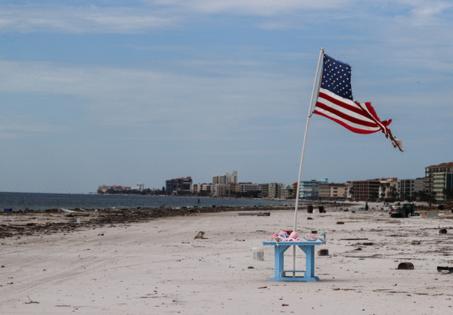Peak hurricane season approaches. How warm is the Gulf of Mexico?
Published in News & Features
Recent hurricane seasons have been defined by storms supercharging over the Gulf of Mexico’s warmer-than-normal waters as they barrel toward Florida’s west coast.
Experts are hopeful that trend could wane this summer, though they still expect the season to be more active than typical.
Researchers at Colorado State University have marginally decreased their season outlook, citing a return to normal water temperatures and high vertical wind shear that works to tear down hurricane strength. The early months of summer rarely spawn powerful storms, but, by mid-July, weather patterns begin to set the stage for what coastal communities should expect come fall.
Meteorologists are now expecting 16 named storms, eight hurricanes and three major hurricanes. In April, the university had predicted one more of each: 17 named storms, nine hurricanes and four majors.
“We are at kind of a critical inflection point of the season where conditions in the Atlantic tend to lock in and persist until the peak of the hurricane season,” said Chandler Jenkins, a graduate student at the university and member of its forecast team.
Jenkins pointed out two things to look for over the coming months: wind shear and trade winds.
Wind shear is the change in wind speed and direction at different altitudes. It can make or break individual storms, and a persisting pattern in the atmosphere can shape many weeks of a season.
Hurricanes form an upright spiral when developing and gaining strength. Vertical wind shear can tilt storms, knocking them off balance and causing them to lose strength, Jenkins said.
Wind shear currently hanging over the Caribbean is acting as a barrier to hurricanes, but it’s not expected to last much longer.
“Long-term models are showing that this wind shear is going to let up in the next couple of weeks and become much more favorable conditions throughout the Atlantic for tropical cyclone formation,” Jenkins said.
Trade winds, another atmospheric wind pattern, play a significant role in global water temperatures.
Faster trade winds stir up waters and cool them, much like winds in the wake of a tropical cyclone.
“If you get weak trade winds, weak tropical winds, the water can kind of sit in place, and it just stagnates and warms up much faster,” Jenkins said.
Trade winds over the Atlantic appear much weaker than earlier this year, Jenkins said. It could mean ocean temperatures heat up as late summer approaches.
Brian McNoldy, a senior research associate at the University of Miami, has closely followed and documented ocean heat content — which measures the total amount of heat stored in deep waters — in major hurricane development areas.
McNoldy watched with concern during the marine heat waves of 2023 and 2024 as his colleagues in South Florida scrambled to save corals from bleaching in record-hot waters. He wasn’t sure then whether gulf temperatures would ever return to normal.
“Water temperatures across the Atlantic have cooled probably a little more than expected back in April, so there’s really not a lot of anomalous warmth anywhere where we would look for hurricanes,” he said. “Nothing even close to what the conditions were in 2023 and ’24.”
That doesn’t mean small, stubborn pockets of heat won’t appear and fuel storms this season.
Last year, Hurricane Milton‘s winds leapt by 90 mph as the storm crossed the gulf’s near record-warm waters just northwest of the Yucatan Peninsula. Milton intensified from a tropical storm to a Category 5 hurricane in just 24 hours.
So far this year, gulf temperatures have held at slightly above average. The gulf’s heat content spiked momentarily in June when clear skies dominated, but weather systems bringing wind and rain this month have cooled much of its surface.
Even so, McNoldy warned Floridians against dropping their guard.
“We get so tuned into the above-average talk,” he said. “But even an average hurricane season is still pretty substantial.”
_____
©2025 Tampa Bay Times. Visit tampabay.com. Distributed by Tribune Content Agency, LLC.







Comments